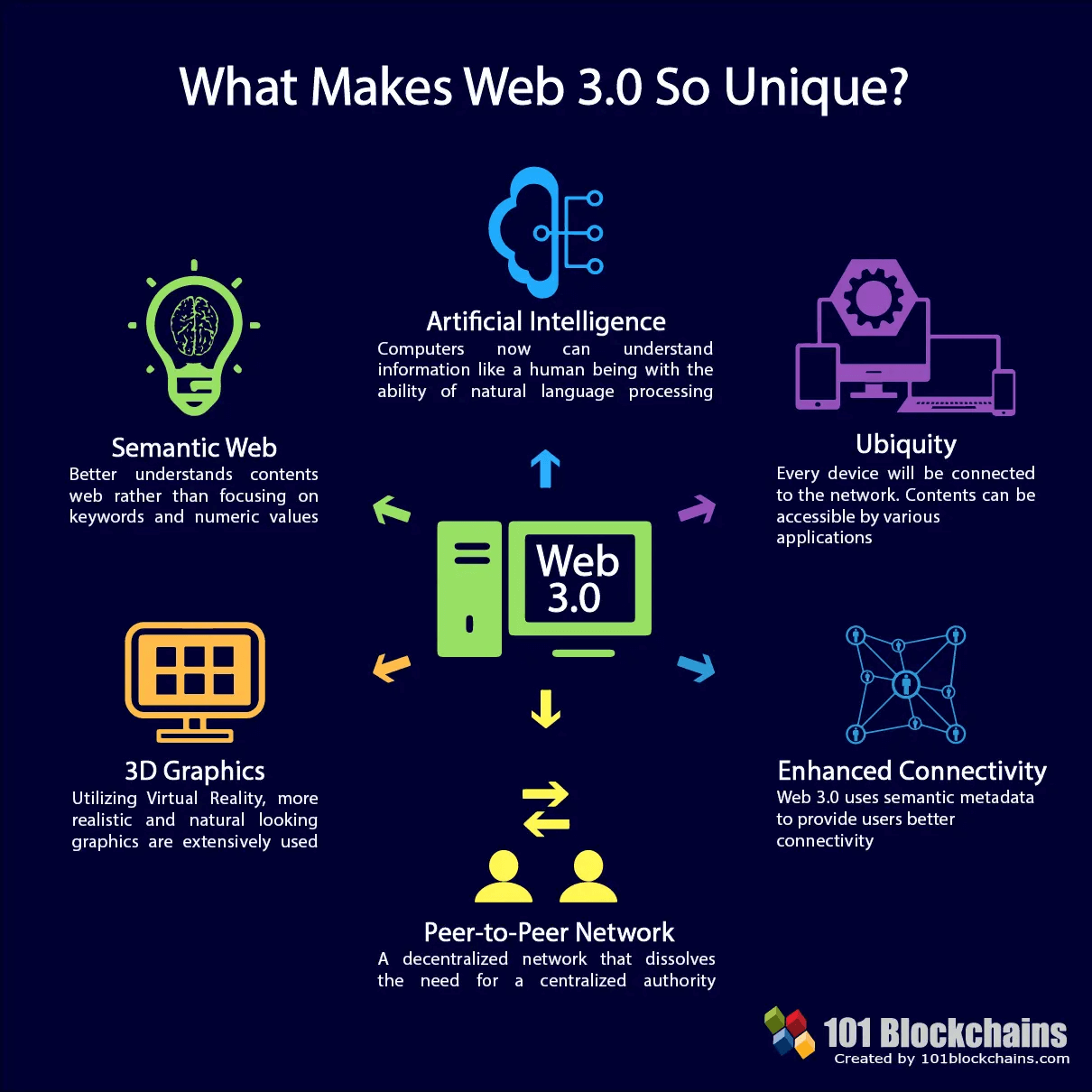Technology has played a critical role in fuelling the advancement of businesses, governance processes, and the everyday lives of people. While many technologies have been responsible for large-scale changes in human civilization, the internet stands out at the top. The internet changed the way people communicated or conducted different activities in their daily life. Most of the discussions pertaining to web3 evolution round up the history of the internet across different stages.
The journey of evolution of the web could offer better clarity regarding the rationale behind the development of web3. It can help in identifying the entities responsible for the introduction of the web3 concept. In addition, the history and existing state of web3 could also provide necessary inputs for determining predictions about its future. The following discussion offers you an overview of the history of web3 and the expectations for its future.
Join Our Annual Membership and become a Featured Member now!
Understanding Web3

The first thing in any web3 guide focuses on its definition to understand it better. A better understanding of web3 can help in setting the tone for the discussion about its history. Let us assume a scenario that can help you understand the web3 landscape better.
Imagine that you wake up on a Sunday morning and pour a cup of coffee into your favorite mug as you wear your virtual headset. You had purchased NFT tickets to a virtual concert of your favorite artist by using cryptocurrency. Now, you can use the NFT ticket to gain access to the immersive 3D experience of the virtual concert. You just witnessed an example of web3 applications in real life. Such examples actually offer a credible answer to “Why is web3 the future?” by presenting a clear glimpse of its potential.
Web3 has become one of the popular terms in the domain of tech recently, which encompasses almost anything that can define the new generation of the internet. The core operations of web3 would rely on a combination of different technologies such as NFTs, blockchain, and cryptocurrencies.
Most important of all, web3 brings back power and access under the control of users. Web3 has been one of the most talked about topics for almost a decade, albeit with different interpretations. Now, web3 is all set to revolutionize the technology experience for internet users. As of now, it is safe to assume that web3 would be all about introducing a new version of the internet with new experiences for users.
Build your identity as a certified blockchain expert with 101 Blockchains’ Blockchain Certifications designed to provide enhanced career prospects.
Tracing Back the Explanations for Web3
The discussion on web3 history would also point towards the origins of web3. Where did the term come from? One of the most confusing aspects of any introduction to web3 is the identity of the founders or proponents of web3. Interestingly, you can find out answers to “Who is behind web3?” by tracing the history of different interpretations of web3.
Which one sits closely with the identity of web3 you see today? Gavin James Wood, the co-founder of Ethereum, is a popular name in the web3 ecosystem for the right reasons. For starters, Ethereum is the preferred platform for developing decentralized applications, which are the foundations of web3. Ethereum has already powered many decentralized applications, while the cryptocurrency, Ether, is a widely popular crypto asset for different use cases.
Gavin Wood provided a definition for web3 in 2014 with a generic explanation for the term. Most recently, Wood illustrated the web3 as an alternative variant of the internet where a single service provider does not host all services for users. On the contrary, web3 services would be completely dependent on completely algorithmic settings. Another important highlight in the definition of web3 by Gavin Wood emphasizes peer-to-peer transactions. As a result, it can create an ecosystem where all the participants serve some form of contribution to the overall experience.
A senior official at Twitter has also envisioned the rationale behind web3 in a brief manner. Any web3 guide would show you that web3 is about creating value that can be shared among more people other than employees, owners, and investors.
Excited to learn the basic and advanced concepts of ethereum technology? Enroll Now in The Complete Ethereum Technology Course
Popular Examples of Web3
The discussion on web3 future would draw heavily on its existing use cases in practice. Popular examples of the practical applications of web3 include marketing activities in the metaverse or peer-to-peer financial transactions through blockchain networks. Community-owned social networking sites and NFTs are also a few examples of how web3 can revolutionize the future of technology. If you look closely at web3, it is a more democratic and decentralized variant of the internet. Therefore, it can work wonders in empowering consumers with true control and ownership over their data.
The web3 blockchain evolution has been characterized by the new functionalities introduced by public blockchain networks. They can fuel new approaches for coordination throughout the internet, money, and finance. Blockchain technology offers an open-source alternative for reducing the necessity of trusting centralized intermediaries. The potential of web3 use cases also shows how it can be quite significant for the future.
Non-fungible tokens accounted for almost $21 billion in sales for the year 2021. At the same time, annual expenses in web3 solutions could round up to almost $12.5 trillion over the next decade. The favorable highlights pertaining to the explanation of web3 and its use cases show that the web3 future is quite promising.
However, the favorable prospects associated with web3 also invite attention to the reasons for which web3 arrived in the first place.
Aspiring to Become a Certified NFT Expert? Enroll in Certified NFT Professional (CNFTP) Course Now!
Evolution of Web3
The answers to “Why is web3 the future?” can be easier to understand when you know the history of web3. You need to find your way back into the early days of the internet and how it advanced to the present stage. As the term ‘web3’ implies, the internet has already passed through two distinct phases. Let us take a look at each phase and what the internet looked like in every era.
- Web 1.0
The first stage of the internet or web 1.0 started off the course of web3 evolution with the arrival of the World Wide Web. Tim Berners-Lee created the internet or web in 1989 as a network for information exchange among scientists, global institutes, and universities. The phase of web 1.0 lasted from around 1989 to around 2005 and primarily emphasized passive, ‘read-only’ experiences. What do you infer by ‘read-only’ experiences? The websites during the first phase of the internet featured a static design alongside a lot of text. Web 1.0 websites focused primarily on standalone pages associated with collections of data interwoven with links.
One of the significant traits of web 1.0 points to the lack of any actual interaction with brands. In addition, web 1.0 did not offer any scope for user-generated content or social media. The only exceptions for such aspects refer to personal webpages and chat rooms, which were the only user-generated content and social media examples in web 1.0.
- Web 2.0
The limitations of web 1.0 set the course for the second stage in web3 blockchain evolution, thereby leading to web 2.0. Interestingly, web 2.0 evolved as a read or wrote internet, which encouraged participation from users. Web 2.0 gained profound momentum owing to Dale Dougherty, one of the pioneers of internet technology.
The era of web 2.0 started off somewhere in the early 2000s and focused primarily on encouraging interactivity. Some of the notable advancements during the web 2.0 phase include blogging and social networking sites. The evolution of the internet into web 2.0 also relied heavily on the arrival of more coding languages. New coding languages offered the opportunity for better customization, thereby leading to the development of many websites based on shared interests.
You might wonder about the necessity of introducing web3 when you have interesting opportunities for using the web with web 2.0. A reliable web3 guide could showcase the exact reasons for which a transition to web3 is essential. The web 2.0 phase brought better possibilities for users to interact with the web. However, the majority of the services in web2 are under the control of centralized servers.
The centralized servers store data about customers, their personal information, financial information, and details about their interactions with different digital applications. In addition, centralized agencies have complete authority over user data generated on different web 2.0 platforms. No matter how many original videos you put up on YouTube, they all are under the ownership of Google. If the company wants to remove the video without any justified reason, it can do so without your permission.
The problem with centralization served as a critical point in web3 history as it emphasized the need for improvement. Users started questioning the integrity of web 2.0 solutions in safeguarding data privacy and ensuring that users have control over their data. For example, big tech companies such as Facebook have come under scrutiny for selling off customer data to marketing companies. The challenges with centralization and data ownership set the grounds for developing a new variant of the internet. Thus, the world rounded up on the notion of web3.
Get familiar with the terms related to Web 3.0 with Web 3.0 Flashcards
Future of Web3
The existing state of web3 and the reasons which fuelled the web3 evolution show what it would look like in the future. Web 3.0 is in the stages of infancy as practical applications have been gaining attention only recently. On the other hand, the value advantages of different web3 use cases show that they can revolutionize the future of the internet. For example, the metaverse could open up the doors to a three-dimensional internet, while DeFi applications can enable decentralized control of your finances. Users could choose what they want to do with the money without depending on centralized intermediaries such as banks.
At the same time, the popularity of non-fungible tokens can also play a vital role in web3 future by driving improvements in asset ownership. The growth of the metaverse can help people familiarize themselves with the basic precedents in the vision for web3, such as decentralization, ubiquity, and cryptographic security. As the discussions around web3 start gaining momentum, it is only a matter of time before new innovations come to the forefront.
Will the story of the internet end with web3? As a matter of fact, discussions around web 4.0 and web 5.0 have started gaining momentum in recent times. Well, you must be wondering about the possible reasons behind introducing web 4.0 and web 5.0 when everything seems perfect with web3.
Web 4.0 would improvise on the ‘semantic web’ trait in web3 and introduce a ‘symbiotic web’, which would be an independent, proactive, collaborative and self-learning. Basically, it would build upon the organization of metadata in web3 for enabling symbiotic interactions between machines and humans. For example, powerful mind-controlled interfaces, virtual reality services or natural language services. One of the biggest highlights about web 4.0 is that it would employ a blend of completely matured reasoning and semantic technologies with AI.
However, the concept of web 4.0 is still in experimental stages. How can anyone think of web 5.0 when its predecessor is still in development? The Ex-CEO and co-founder of Twitter, Jack Dorsey, begs to differ. According to Jack Dorsey, web3 is riddled with a lot of pitfalls, especially with respect to decentralization. Therefore, his vision of leveraging blockchain for developing web 5.0 focuses on empowering users with true control over their data.
Web 5.0 emphasizes on lack of true decentralization in web3 and suggests that limited partners and venture capitalists exercise control over web3. On the contrary, Web 5.0 would define the single digital identity of users so they don’t have to create multiple usernames and passwords for accessing multiple services. Even if Web 5.0 might seem like a topic for the future, it is a representative of what could change with the internet and how we use it.
Aspiring to Become a Certified Metaverse Expert? Enroll in Certified Metaverse Professional (CMP) Certification Course Now!
Bottom Line
The detailed overview of the existing state of web3 complemented with the origins of web3 show a credible impression of its potential. Many people are generally concerned about “Who is behind web3?” while the attention should rightly go to the improvements it brings forward. Web3 has evolved as a solution to the problems of centralization and data ownership in web2 systems.
Over the course of time, web3 has become stronger with notable interventions in the form of NFTs and DeFi. On top of it, the metaverse also presents many favorable prospects for planning the growth of the internet. However, it is important to note that blockchain networks are the most significant element responsible for driving web3 advancements. Learn more about the evolution of web3 and the potential trends you can expect in its future.
Join our annual/monthly membership program and get unlimited access to 30+ professional courses and 55+ on-demand webinars.
*Disclaimer: The article should not be taken as, and is not intended to provide any investment advice. Claims made in this article do not constitute investment advice and should not be taken as such. 101 Blockchains shall not be responsible for any loss sustained by any person who relies on this article. Do your own research!



